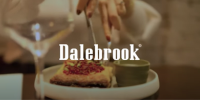When choosing a jacket it is crucial to consider the beneficial features it has, the quality of materials used and how easy it is to clean and maintain...

History
The chefs’ jacket is a crucial component in a chef’s uniform or ‘whites’. There is some disagreement surrounding the origin of chefs’ whites but the most common theory points to France. One story claims Napoleon asked for his chefs to be dressed more like his soldiers. Here at Lockhart we live by this version of events; a day working in a kitchen can feel a lot like heading into battle and the new Military Chefs’ Jacket designed by chefs clothing brand Sharp proves us right.
The classic chefs' jacket we see today is credited to 19th century French chef Marie Antoine Careme. This design was brought to the UK when Georges Auguste Escoffier managed the kitchens of the prestigious London hotels, the Savoy and the Carlton. Skipping forward to the 21st century, chefs’ jackets are forever updating to meet the needs and pressures of modern kitchens.
Guide To Features
A chef’s jacket should make the wearer look clean-cut and professional at the same time as offering practical benefits. Consider the most important issues you face when working in the kitchen and prioritise the below extra features accordingly.
- COOLMAX Fabric Technology - this new innovative COOLMAX fabric can keep the wearer cooler for longer. COOLMAX fabric panels in jackets will keep chefs cool in the pressure of a hot kitchen and are a helpful feature to hunt for in your new chefs’ clothing.
- Apron Loops - if you’re the kind of chef who lives with an apron over your jacket then this is a brilliant feature for you. Designed to hold your apron in place during busy shifts, this little loop could make a big difference to your working environment.
- Coated Wax Fabric - some innovative aprons are now made with coated fabrics to make them easier to clean and smarter to look at. Food preparation is no longer a food fight with this feature as you can remain looking professional and clean even in the middle of a service.
- 3D Body Shaping - to make working in a kitchen cleaner and more comfortable choose a chefs’ jacket with a 3D fit. Designed to provide you with greater levels of movement and flexibility, this classic style of jacket fits your body more accurately and can prevent food spills.
- Fashionable Designs - the 21st century has seen revolutions in the fashion industry and these do not stop at the kitchen door. Chefs’ clothing has seen waves of new and innovative design features to make staff, including those who work front of house feel as good as they look. Consider fashionable features such as camo print colours and new materials when choosing your chefs’ clothing.
- Necklines- often the place we feel discomfort the most, it is important to think about the best neckline for your chefs’ jacket. Some designs now include chambray inner collars for comfort and lower fits to give your neck more room to move.
- Embroidery Eyelets - it is common knowledge that kitchens are hot and heat makes us sweat. However as a chef, sweating is the last thing you want to be doing. Embroidery eyelets are designed to increase airflow and maintain a lower body temperature in sweat-prone areas of your body.
- Air Vent Seams- in similar way to COOLMAX fabric and eyelets, air vent seams control your body heat and keep you cooler for longer in hot kitchens.
- Pen pocket -A lot of chefs’ jackets have a pen pocket incorporated into one of the coat’s sleeves. This can be handy to store a pen or other implements like a chef’s thermometer.
- Extra Pockets - in addition to a pocket for a pen, some jackets include sleeve pockets for increased accessibility and functionality.
- Double breasted - The double breasted nature of a chefs’ jacket means it can easily be reversed to hide stains. It also incorporates a double layer of material, giving added protection from hot stoves or splashes.
- Dropped shoulder - A chef jacket usually features a slightly dropped shoulder, which gives a looser fit across the back, allowing for increased mobility.
- Knotted cloth or studded buttons - The fastenings on chefs’ coats are designed to work with the heat of the kitchen and allow you to remove the jacket quickly should you spill something hot on yourself. Traditionally chef buttons have been made of knotted cloth, which wash well. Studded buttons are another popular option.
- Sleeves - For year round comfort, chefs’ jacket sleeves come in long, short and three quarter lengths. Whether you choose a long or short-sleeved chefs’ jacket, the cuffs allow for breathability and can be rolled up or down when working on hot stations. The French cuff is a slightly more formal style that remains very popular.
- Reinforced and taped seams -To protect against chaffing in key areas such as under the arm, jacket seams are often taped or reinforced, which also promotes durability.
Materials
Chefs’ jackets were traditionally made of cotton because of its breathability, though now there are many more choices available. Cotton and poly cotton chefs’ jackets each have their merits.
• Poly cotton - A mix of polyester and cotton threads, poly cotton is hardwearing, durable, and easy to launder and requires little to no ironing.
• Satin cotton - This is extremely high quality cotton with a luxury feel that offers good breathability. As such, it generally costs more and it can take a little more effort to maintain.
In addition to the material, you must also consider the colour of your chefs’ outfits. We live in a century where not all chefs are expected to wear traditional white uniforms however there are benefits and downsides to each choice. Wearing black in a kitchen will minimise the visibility of spills and splashes much better than a white jacket ever could. In spite of this, most chefs want to appear professional and hygienic and see white as the only jacket of choice. White is the traditional and conventional colour of chefs’ jackets and although it fails to hide spills the majority of chefs wear traditional striped aprons over the top anyway.
Product Care
Keeping a chefs’ jacket clean is often an impossible task, even with the help of an apron. For hygiene reasons, most chefs change into their chef uniform - also known as chefs' whites - at the restaurant. The venue or chef themselves may be responsible for laundering the garments, which therefore need to be able to withstand commercial laundering. When washing a chefs’ jacket, always follow the wash instructions on the care label. If possible, avoid tumble drying a jacket if stains haven´t been fully washed out as this can set a stain. Some chefs like to carry a detergent pen or stain remover wipes to catch quick spills before they stain, but again you should ensure these are compatible with the fabric. In recognition of the hard work that goes into maintaining a chefs’ uniform, chefs in the UK are able to claim a tax rebate on the laundering and care of uniforms, so there´s no need to skimp on the softener.
Having a well-fitted chef jacket is not just a matter of looking professional it’s also about comfort and safety. Too tight a jacket will make a sweltering kitchen seem like an inferno and too loose will increase the probability of catching on cupboard doors or boiling liquids hitting your skin instead of the fabric. To find out what size chefs jacket you’ll need, measure around the fullest part of your chest, positioning the tape under the arms and across the shoulder blades, keeping the tape level but not pulled too tight. When you receive your jacket, it should fit a little like a longer version of a traditional dress shirt, with four or five inches of extra fabric around your middle to allow for movement and comfort.




Leave a comment